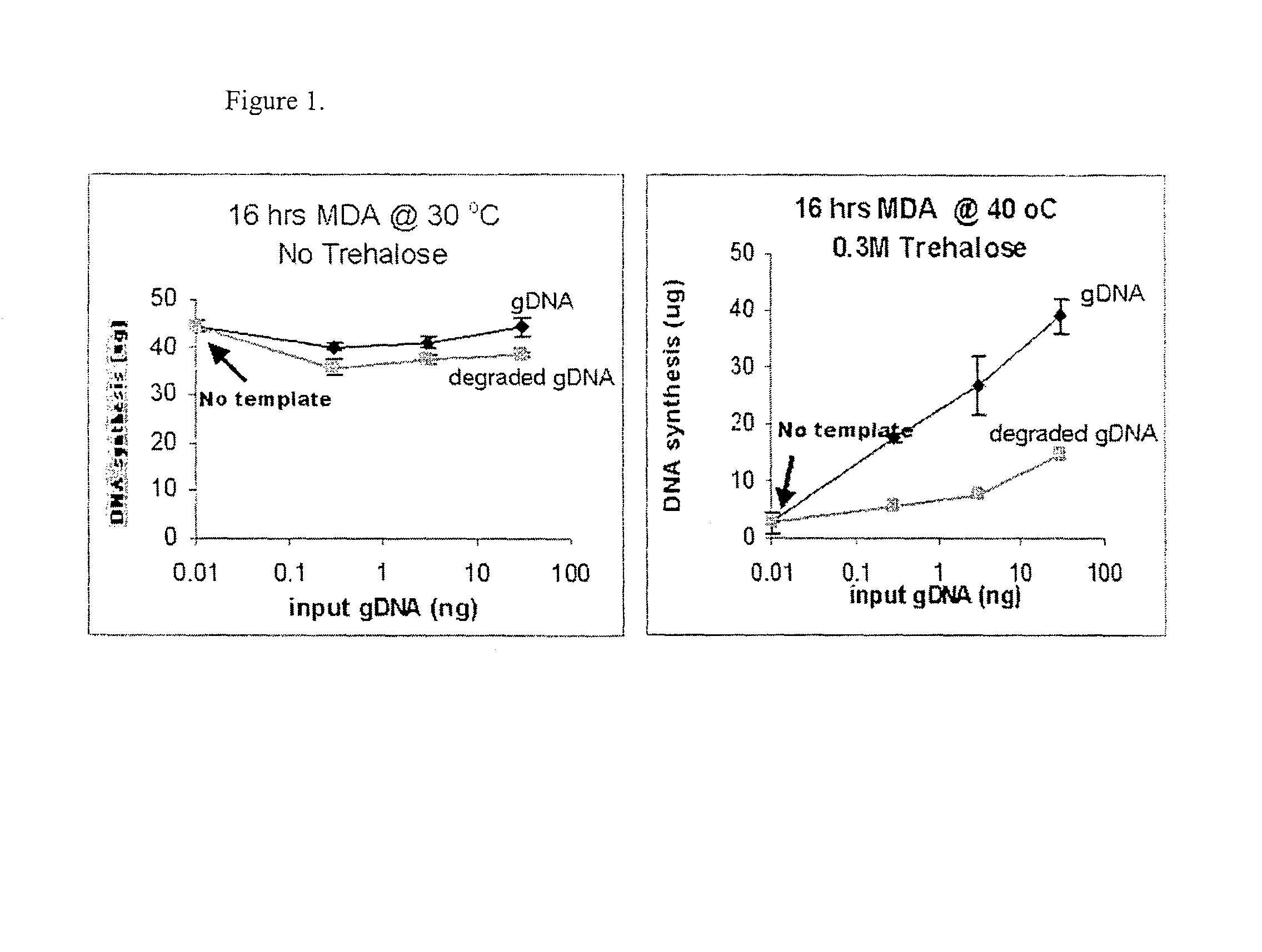Method of whole genome amplification with reduced artifact production
a technology amplification method, which is applied in the field of nucleic acid amplification, can solve the problems of phi29 dna polymerase also producing undesirable artifacts, complicating the effort to distinguish contaminant template from specific input template, etc., and achieves the reduction or undetectable levels of artifactual nucleic acids, reduce or undetectable levels of artifactual nucleic acids, reduce or und
- Summary
- Abstract
- Description
- Claims
- Application Information
AI Technical Summary
Benefits of technology
Problems solved by technology
Method used
Image
Examples
specific embodiments
Disclosed is a method of amplifying nucleic acids, the method comprising incubating nucleic acids comprising target sequences at an elevated temperature in the presence of a thermolabile nucleic acid polymerase having strand displacement activity, an additive, and a set of primers, under conditions promoting replication of the nucleic acids. Replication of the nucleic acids results in replicated strands. During replication at least one of the replicated nucleic acid strands is displaced by strand displacement replication of another replicated strand. Formation of replicated strands from the target sequences is favored over formation of replicated strands from non-target sequences.
Also disclosed is a method of amplifying a whole genome, the method comprising exposing cells to alkaline conditions to form a cell lysate, reducing the pH of the cell lysate to form a stabilized cell lysate, and incubating stabilized cell lysate at an elevated temperature in the presence of a thermolabile ...
example 1
A. Example 1
Measurement of DNA Synthesis in MDA Reaction Carried Out at in the Absence of any Additive at 30° C. or in the Presence of 0.3 M Trehalose at 40° C.
MDA reactions were carried out at 30° C. with no additive or at 40° C. with 0.3 M Trehalose, essentially using the protocol described above for high temperature MDA. The quantity of input template was either 0 ng, 0.3 ng, 3 ng, or 30 ng. After 16 hrs of MDA reaction at described temperature, the total DNA synthesis was quantitated by using picogreen assay. The results are shown in FIG. 2.
example 2
B. Example 2
Measurement of DNA Synthesis in a 16 hrs. MDA Reaction Carried Out at 40° C. in the Presence of no Additive or 0.3 M Trehalose or 0.4 M Sucrose or 0.4 M Glucose
MDA reactions were carried out at 40° C. either with no additive or in the presence of 0.3 M Trehalose or 0.4 M Sucrose or 0.4 M Glucose, essentially using the protocol described above for high temperature MDA. The quantity of input template was either 0 ng or 0.003 ng or 0.03 ng or 0.3 ng or 3 ng or 30 ng. After 16 hrs of MDA reaction, the total DNA synthesis was quantitated by using picogreen assay. The results are shown in FIG. 3.
PUM
| Property | Measurement | Unit |
|---|---|---|
| Temperature | aaaaa | aaaaa |
| Temperature | aaaaa | aaaaa |
| Temperature | aaaaa | aaaaa |
Abstract
Description
Claims
Application Information
 Login to View More
Login to View More - R&D
- Intellectual Property
- Life Sciences
- Materials
- Tech Scout
- Unparalleled Data Quality
- Higher Quality Content
- 60% Fewer Hallucinations
Browse by: Latest US Patents, China's latest patents, Technical Efficacy Thesaurus, Application Domain, Technology Topic, Popular Technical Reports.
© 2025 PatSnap. All rights reserved.Legal|Privacy policy|Modern Slavery Act Transparency Statement|Sitemap|About US| Contact US: help@patsnap.com


